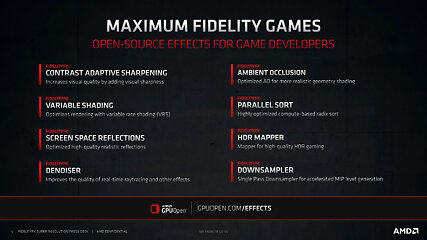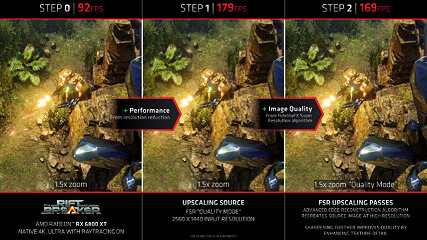 218
218
AMD FSR FidelityFX Super Resolution Quality & Performance Review
Test Setup & Methodology »How AMD FidelityFX Super Resolution Works
The name FidelityFX has been around for a while, it's a combination of various turnkey game effects and image quality enhancements given to game developers under AMD's GPUOpen initiative. FidelityFX Super Sampling, the subject of this review, is a feature that lets you significantly improve the performance of your game at minimal cost to visual quality.
Your game is rendered at a resolution lower than your display resolution, and the resulting image is processed through an upscaling algorithm that attempts to reconstruct details.
FidelityFX Super Sampling (FSR) is integrated into the game as a shader-based post-processing code. It's agnostic to the hardware beyond programmable shaders and can thus run even on NVIDIA hardware. Within the game engine's rendering path, FSR sits between a tone-mapped anti-aliased output of the lower-resolution render and post-FX that can introduce visual noise, such as filmgrain. Only the 3D graphics are processed, the HUD is overlaid later, so it's always rendered at the native resolution. The FidelityFX Super Sampling upscaler operates in two passes. One is an upscaling pass, which uses a spatial upscaling algorithm that detects the edges in the image and sharpens them, while attempting to preserve details, and the other is a sharpening pass, which "adds" crispness to textures to improve image quality.
This is a completely different approach than NVIDIA DLSS 2.0, which looks at multiple images in a sequence, so it has additional pixel information. NVIDIA DLSS also requires game developers to provide them with motion vectors to avoid rendering errors due to this temporal appraoch. FSR is much simpler and requires no engine integration (other than the FSR shader render pass).
At what resolution your game is actually rendered is decided by the FSR quality preset you choose in your game's settings.


The various quality presets alter the render resolution, and hence impact resolution. With each step, you trade image quality for performance. The table above lists the various render resolutions for target display resolutions based on the quality presets. Since the scale factor changes with each preset, the performance gained between the native resolution and highest performance setting can be drastic.
Since FSR is essentially a drop-in render stage, practically any game can integrate it, and any current-generation hardware can run it. AMD is hence working to integrate it with as many game engines and games already launched or in development as possible. While Epic Games / Unreal Engine is not listed here, we have tested Unreal Engine based titles today, and FSR work perfectly fine in them.
Apr 13th, 2025 05:19 EDT
change timezone
Latest GPU Drivers
New Forum Posts
- Bought a Sapphire RX 7900 XT and..... (7)
- What's your latest tech purchase? (23538)
- Dune: Awakening benchmark - post your results (52)
- What is going to be your next tech upgrade? just curious :) (32)
- 5080 and 5070/Ti cards available at MSRP in the UK (4)
- Good bluetooth controller with Android support (3)
- works and stops, random colored screens, Biostar RX560 896SPs (3)
- SK hynix A-Die (Overclocking thread) only for RYZEN AM5 users (26)
- Upgrade for a GTX-1060 video card to a X570 AM4 MB w/ a Ryzen 9 3900X (12)
- RTX5000 Series Owners Club (166)
Popular Reviews
- Thermaltake TR100 Review
- The Last Of Us Part 2 Performance Benchmark Review - 30 GPUs Compared
- TerraMaster F8 SSD Plus Review - Compact and quiet
- Zotac GeForce RTX 5070 Ti Amp Extreme Review
- ASUS GeForce RTX 5080 TUF OC Review
- ASRock Z890 Taichi OCF Review
- Sapphire Radeon RX 9070 XT Pulse Review
- Sapphire Radeon RX 9070 XT Nitro+ Review - Beating NVIDIA
- Upcoming Hardware Launches 2025 (Updated Apr 2025)
- MSI MAG CORELIQUID A15 360 Review
Controversial News Posts
- NVIDIA GeForce RTX 5060 Ti 16 GB SKU Likely Launching at $499, According to Supply Chain Leak (181)
- MSI Doesn't Plan Radeon RX 9000 Series GPUs, Skips AMD RDNA 4 Generation Entirely (146)
- Microsoft Introduces Copilot for Gaming (124)
- NVIDIA Sends MSRP Numbers to Partners: GeForce RTX 5060 Ti 8 GB at $379, RTX 5060 Ti 16 GB at $429 (121)
- Nintendo Confirms That Switch 2 Joy-Cons Will Not Utilize Hall Effect Stick Technology (105)
- Over 200,000 Sold Radeon RX 9070 and RX 9070 XT GPUs? AMD Says No Number was Given (100)
- Nintendo Switch 2 Launches June 5 at $449.99 with New Hardware and Games (99)
- NVIDIA PhysX and Flow Made Fully Open-Source (77)







